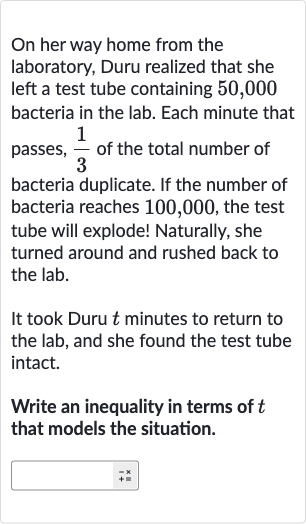AI tutor
Welcome to Bytelearn!
Let’s check out your problem:

On her way home from the laboratory, Duru realized that she left a test tube containing , bacteria in the lab. Each minute that passes, of the total number of bacteria duplicate. If the number of bacteria reaches , , the test tube will explode! Naturally, she turned around and rushed back to the lab.It took Duru minutes to return to the lab, and she found the test tube intact.Write an inequality in terms of that models the situation.
Full solution
Q. On her way home from the laboratory, Duru realized that she left a test tube containing , bacteria in the lab. Each minute that passes, of the total number of bacteria duplicate. If the number of bacteria reaches , , the test tube will explode! Naturally, she turned around and rushed back to the lab.It took Duru minutes to return to the lab, and she found the test tube intact.Write an inequality in terms of that models the situation.
- Given Information: We are given that the number of bacteria duplicates by of its total every minute. This means that if we start with bacteria, after one minute, we will have bacteria. This is a geometric progression where each term is times the previous term.
- Initial Bacteria Count: Let's denote the initial number of bacteria as . After minutes, the number of bacteria will be . We want this number to be less than , to prevent the test tube from exploding.
- Inequality Setup: We can now set up the inequality that models the situation:50,000 \times \left(\frac{4}{3}\right)^t < 100,000.
- Isolating Exponential Term: To solve for , we can divide both sides of the inequality by , to isolate the exponential term:\left(\frac{4}{3}\right)^t < \frac{100,000}{50,000}.
- Simplify Right Side: Simplifying the right side of the inequality gives us:\left(\frac{4}{3}\right)^t < 2.
- Applying Logarithm: Now, we need to find the value of that satisfies this inequality. Since is greater than , the function is increasing, and we can apply the logarithm to both sides of the inequality to solve for . However, since we are only asked to write the inequality in terms of , we do not need to solve for explicitly.
More problems from Write and solve equations for proportional relationships
QuestionGet tutor help
QuestionGet tutor help
QuestionGet tutor help
QuestionGet tutor help
QuestionGet tutor help
QuestionGet tutor help
QuestionGet tutor help
QuestionGet tutor help
QuestionGet tutor help
